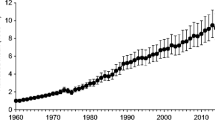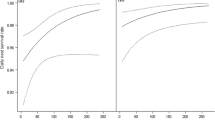Abstract
We present data accumulated over the last 25 years on predation of radio-tracked released pheasants. In studies of birds during the autumn/winter at six pheasant shoots with high-density releases managed by full-time gamekeepers, predation of released pheasants by foxes before the shooting season began (July–September) averaged 19.2 ± 4.0% per site, and during the shooting season (October 1st–February 1st), a further 15.9 ± 1.9% were predated. The range in 3-year average predation rates between sites before shooting began was 8.6 to 42.4%. At seven different sites during the spring and summer, between 20 and 71% of released or wild hens that survived the shooting season were predated, mainly by foxes, between mid-March and mid-July. Predation was significantly higher at sites with low-level predator control (59 ± 4.7%) compared to those with high-level control (30 ± 5.3%). At three of the four sites with low predator control between 5 and 22% of nest failures were caused by incubating hens being predated by foxes. Our data quantify for the first time highly variable predation rates of released pheasants before and during the winter shooting season which we suggest was influenced by a range of site and management factors. During the spring and summer, our data provide evidence that predation of adult hen pheasants as well as nest predation can suppress breeding success and that predator control can reduce these losses.
Similar content being viewed by others
References
Bliss TH, Anderson BC, Draycott RAH, Carroll JP (2005) Survival of wild pheasants (Phasianus colchicus) on a managed hunting estate in Lower Austria. In: Pohlmeyer K (ed) Extended abstracts of the XXVIIth congress of the International Union of Game Biologists, Hannover 2005. DSV-Verlag, Hamburg, pp 50–51
Bolton M, Tyler G, Smith K, Bamford R (2007) The impact of predator control on lapwing Vanellus vanellus breeding success on wet grassland nature reserves. J Appl Ecol 44(3):534–544. https://doi.org/10.1111/j.1365-2664.2007.01288.x
Brickle NW, Harper DGC, Aebischer NJ, Cockayne SH (2000) Effects of agricultural intensification on the breeding success of corn buntings Miliaria calandra. J Appl Ecol 37(5):742–755. https://doi.org/10.1046/j.1365-2664.2000.00542.x
Brittas R, Marcström V, Kenward RE, Karlbom M (1992) Survival and breeding success of reared and wild ring-necked pheasants in Sweden. J Wild Man 56(2):368–376. https://doi.org/10.2307/3808836
Coté IM, Sutherland WJ (1997) The effectiveness of removing predators to protect bird populations. Conserv Biol 11(2):395–405. https://doi.org/10.1046/j.1523-1739.1997.95410.x
Defra (2008) Numbers of pheasant and partridge premesis and birds by regisitered county. Radar Report: RP6337. Department of Environment, Farming and Rural Affairs
Desforges M, Wood-Gush DGM (1975) A behavioural comparison of domestic and mallard ducks: habituation and flight reactions. Anim Behav 23:692–697. https://doi.org/10.1016/0003-3472(75)90145-1
Donald PF, Evans AD, Muirhead LB, Buckingham DL, Kirby WB, Schmitt SIA (2002) Survival rates, causes of failure and productivity of skylark Alauda arvensis nests on lowland farmland. Ibis 144(4):652–664. https://doi.org/10.1046/j.1474-919X.2002.00101.x
Dowell SD (1990) The ontogeny of anti-predator behaviour in gamebird chicks. Unpublished D.Phil. Thesis, University of Oxford
Draycott RAH, Woodburn MIA, Ling DE, Sage RB (2006) The effect of an indirect anthelmintic treatment on parasites and breeding success of free-living pheasants Phasianus colchicus. J Helminth 80(4):409–415. https://doi.org/10.1017/JOH2006367
Draycott RAH, Hoodless AN, Woodburn MIA, Sage RB (2008) Nest predation of common pheasant Phasianus colchicus. Ibis 150:37–44. https://doi.org/10.1111/j.1474-919X.2008.00851.x
Fletcher K, Aebischer NJ, Baines D, Foster R, Hoodless AN (2010) Changes in breeding success and abundance of ground-nesting moorland birds in relation to the experimental deployment of legal predator control. J Appl Ecol 47(2):263–272. https://doi.org/10.1111/j.1365-2664.2010.01793.x
Game Conservancy Trust (1970) The game conservancy annual review of 1969. Fordingbridge, Hampshire
Game Conservancy Trust (1988) Woodlands for pheasants. The Game Conservancy, Fordingbridge, Hampshire
Game Conservancy Trust (1990) Gamebird rearing. The Game Conservancy, Fordingbridge, Hampshire
Game Conservancy Trust (1991) Gamebird releasing. The Game Conservancy, Fordingbridge, Hampshire
Game Conservancy Trust (2005) Predator control. The Game Conservancy, Fordingbridge, Hampshire
Haensly TF, Meyers SM, Crawford JA, Castillo WJ (1985) Treatments affecting post-release survival and productivity of pen-reared ring-necked pheasants. Wildl Soc Bull 13:521–528
Hessler E, Tester JR, Siniff DB, Nelson MM (1970) A biotelemetery study of survival of pen-reared pheasants released in selected habitats. J Wild Man 34(2):267–273. https://doi.org/10.2307/3799010
Hill DA (1984) Population regulation in the mallard (Anas platyrhynchos). J Anim Ecol 53(1):191–202. https://doi.org/10.2307/4351
Hill DA, Robertson PA (1988) Breeding success of wild and hand reared ring necked pheasants. J Wild Man 52(3):446–450. https://doi.org/10.2307/3801588
Holt AR, Davies ZG, Tyler C, Staddon S (2008) Meta-analysis of the effects of predation on animal prey abundance: evidence from UK vertebrates. PLoS One 3(6):e2400. https://doi.org/10.1371/journal.pone.0002400
Hoodless AN, Coulson JC (1998) Breeding biology of the woodcock Scolopax rusticola in Britain. Bird Study 45(2):195–204. https://doi.org/10.1080/00063659809461091
Hoodless AN, Draycott RAH, Ludiman MN, Robertson PA (1999) Effects of supplementary feeding on territoriality, breeding success and survival of pheasants. J Appl Ecol 36(1):147–156. https://doi.org/10.1046/j.1365-2664.1999.00388.x
Jarvis RL, Engbring J (1976) Survival and reproduction of wild and game farm pheasants in western Oregon. Northwest Sci 50:222–230
Kenward RE, Hall DG, Walls SS, Hodder KH (2001) Factors affecting predation by buzzards Buteo buteo on released pheasants Phasianus colchicus. J Appl Ecol 38(4):813–822. https://doi.org/10.1046/j.1365-2664.2001.00636.x
Leif AP (1994) Survival and reproduction of wild and pen-reared ring necked pheasant hens. J Wild Man 58(3):501–506. https://doi.org/10.2307/3809322
Mayot P (2003) Repeuplement de faisans en été: volière à ciel ouvert ou petite volière de pré-lâcher? (Pheasant restocking in summer: English pen or small pre-releasing pen?). Faune Sauvage 258:15–19
Musil DD, Connelly JW (2009) Survival and reproduction of pen-reared vs translocated wild pheasants Phasianus colchicus. Wildl Biol 15(1):80–88. https://doi.org/10.2981/07-049
Nicoll M, Norris K (2010) Detecting an impact of predation on bird populations depends on the methods used to assess the predators. Methods Ecol Evol 1:300–310
PACEC (2006) Economic and environmental impact of sporting shooting in the UK. PACEC, Cambridge
Pearse AT, Ratti JT (2004) Effects of predator removal on mallard duckling survival. J Wild Man 68(2):342–350. https://doi.org/10.2193/0022-541X(2004)068[0342:EOPROM]2.0.CO;2
Potts GR (1986) The partridge–pesticides, predation and conservation. Collins, London
Potts G.R. (2012) Partridges–countryside barometer. The New Naturalist Library, Collins, London
Reynolds JC, Angelstam P, Redpath SM (1988) Predators, their ecology and impact in gamebird populations. In: Hudson PJ, Rands MW (eds) Ecology and management of gamebirds. BSP, Oxford, pp 72–97
Riley TZ, Schulz JH (2001) Predation and ring-necked pheasant population dynamics. Wildl Soc Bull 29:33–38
Robertson PA, Dowell SD (1990) The effects of hand-rearing on wild gamebird populations. In: Lumeij JT, Hoogeveen YR (eds) The future of wild Galliformes in the Netherlands: 158–171. Organisatie commissie Nederlandse Wilde Hoenders, Amersfoort
Robertson PA, Rosenberg AA (1988) Harvesting gamebirds. In: Hudson PJ, Rands MW (eds) Ecology and management of gamebirds. BSP, Oxford, pp 177–201
Robertson PA, Woodburn MIA, Neutal W, Bealey CL (1993) Effects of land use on breeding pheasant density. J Appl Ecol 30(3):465–477. https://doi.org/10.2307/2404187
Sage RB, Robertson PA (2000) Pheasant productivity in relation to population density and rearing: a meta analysis. Hung Small Game Bull 5:15–28
Sage RB, Robertson PA, Wise DR (2001) Survival and breeding success of two ring-necked pheasant Phasianus colchicus strains released into the wild. Proceedings of Perdix VII, Tome 2. Game Wildl Sci 18:331–340
Sage RB, Putaala A, Pradell-Ruiz V, Greenall TL, Woodburn MIA, Draycott RAH (2003) Incubation success of released hand-reared pheasants Phasianus colchicus compared with wild ones. Wildl Biol 9:179–184
Sage RB, Ludolf IC, Robertson PA (2005) The effect of pheasant release pens on the ground flora of ancient semi-natural woodland in England. Biol Conserv 121:243–252
Storch I, Woitke E, Krieger S (2005) Landscape-scale edge effect in predation risk in forest-farmland mosaics of central Europe. Landsc Ecol 20(8):927–940. https://doi.org/10.1007/s10980-005-7005-2
Tapper SC (1999) A question of balance—the game conservancy trust, Fordingbridge, Hampshire
Tapper SC, Potts GR, Brockless MH (1996) The effect of an experimental reduction in predation pressure on the breeding success and population density of grey partridges Perdix perdix. J Appl Ecol 33(5):965–978. https://doi.org/10.2307/2404678
Turner CV (2007) The fate and management of pheasants Phasianus colchicus released in the UK. Unpubl PhD thesis, University of London
Woodburn MIA (1999) Comparative population dynamics of wild and reared pheasants (Phasianus colchicus). Unpubl PhD thesis, University of Southampton
Author information
Authors and Affiliations
Corresponding author
Rights and permissions
About this article
Cite this article
Sage, R.B., Turner, C.V., Woodburn, M.I.A. et al. Predation of released pheasants Phasianus colchicus on lowland farmland in the UK and the effect of predator control. Eur J Wildl Res 64, 14 (2018). https://doi.org/10.1007/s10344-018-1174-1
Received:
Revised:
Accepted:
Published:
DOI: https://doi.org/10.1007/s10344-018-1174-1




